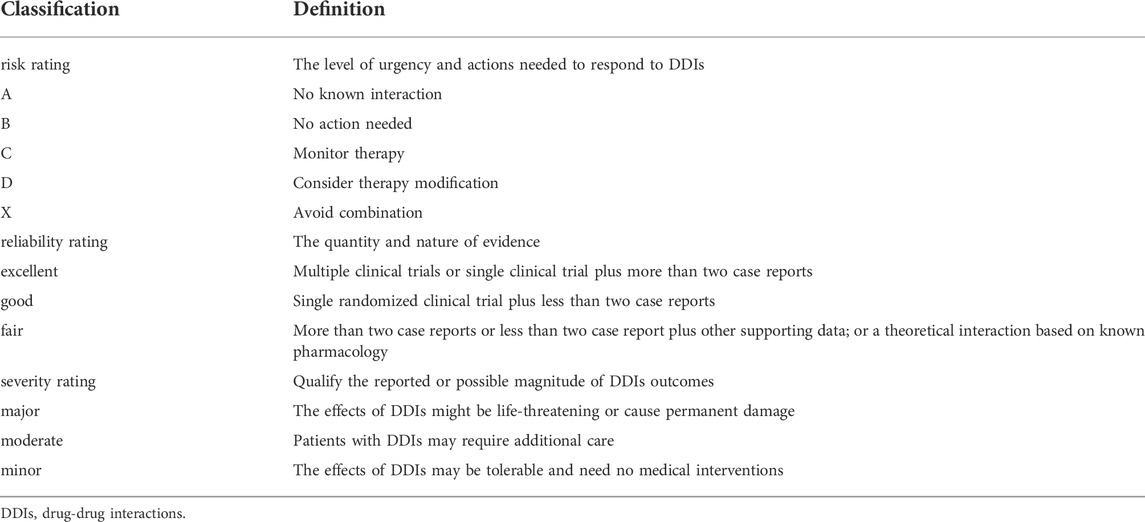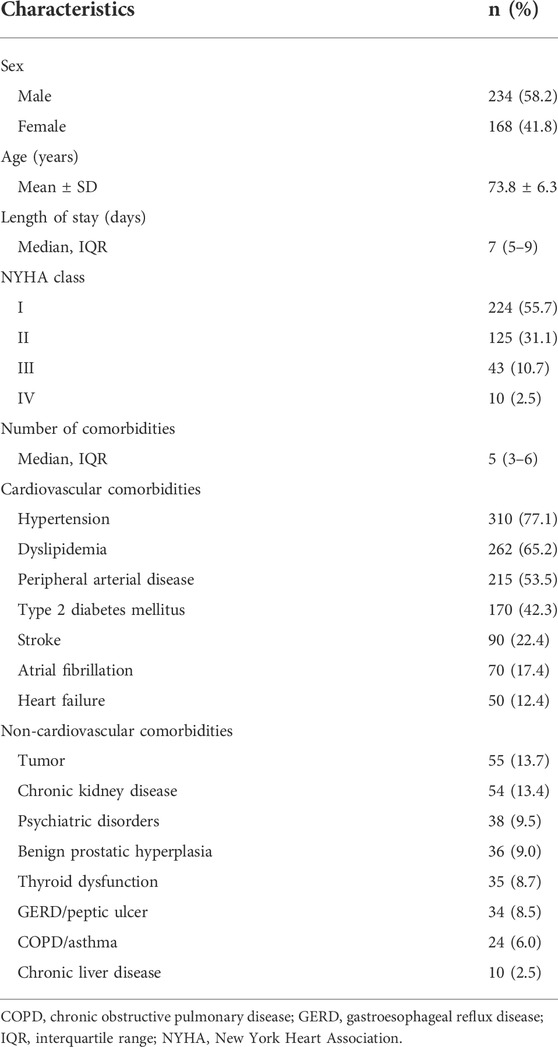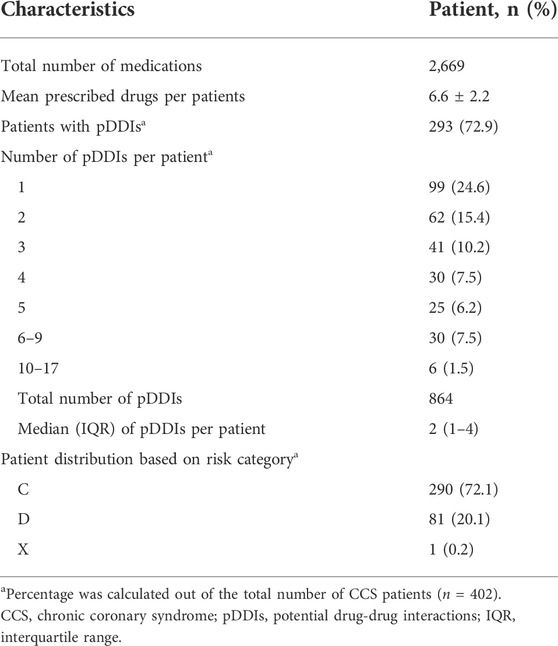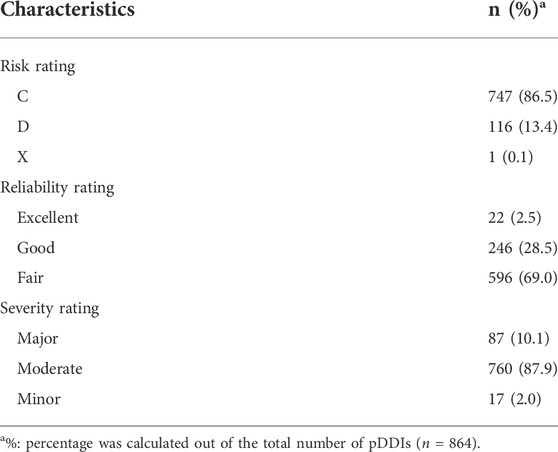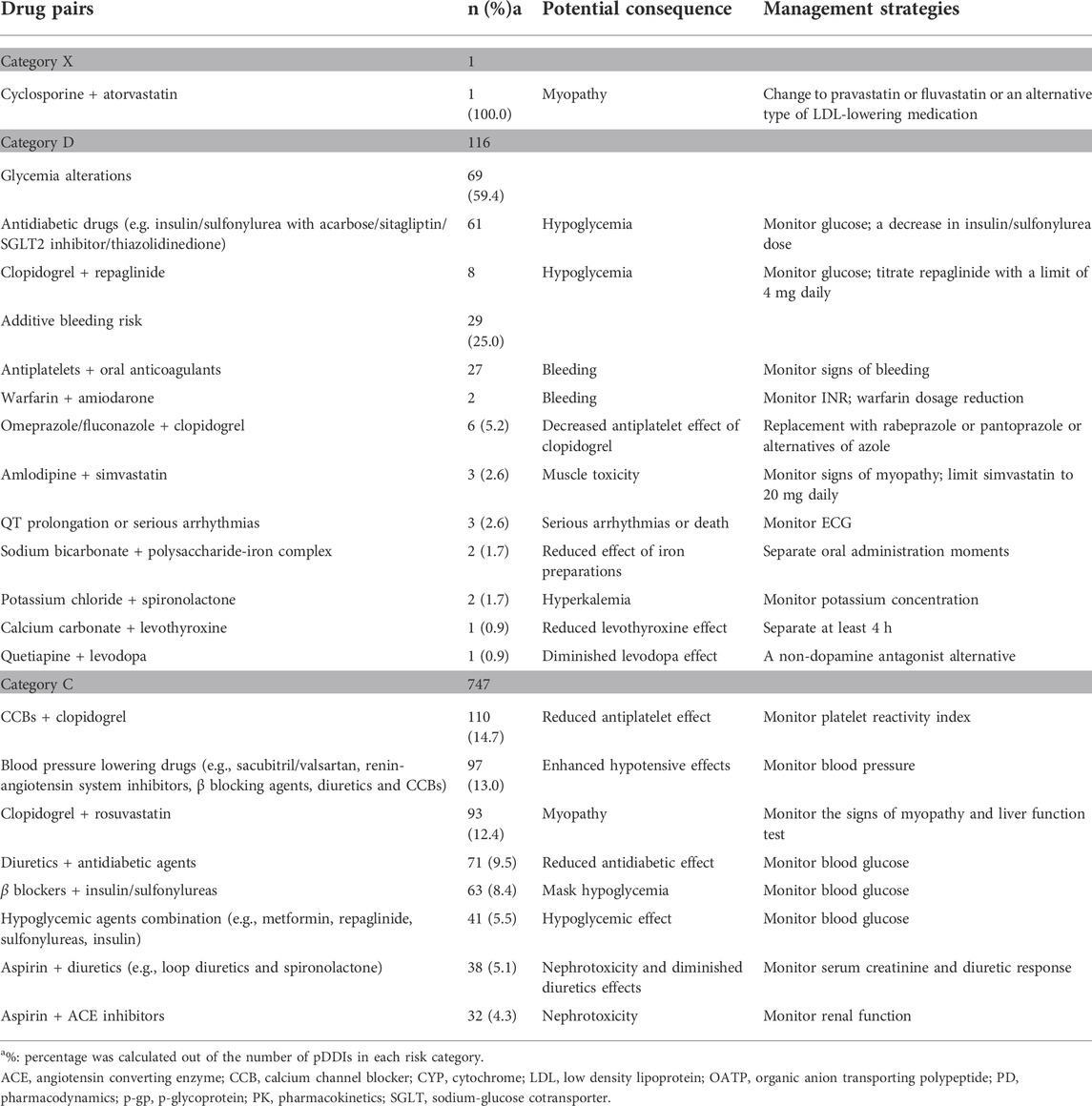- 1Department of Pharmacy, Peking University People’s Hospital, Beijing, China
- 2Department of Cardiology, Peking University People’s Hospital, Beijing, China
- 3Beijing Key Laboratory of Early Prediction and Intervention of Acute Myocardial Infarction, Peking University People’s Hospital, Beijing, China
- 4Center for Cardiovascular Translational Research, Peking University People’s Hospital, Beijing, China
Introduction: Polypharmacy are commonly observed among older adults with cardiovascular disease. However, multiple medications lead to increased risk of drug-drug interactions (DDIs). Therefore, identification and prevention actions related to harmful DDIs are expected in older adults. The study aimed to describe the prevalence of potential DDIs (pDDIs) in discharge prescriptions among older adults with chronic coronary syndrome (CCS).
Methods: A single-center cross-sectional study was performed in a tertiary public hospital in Beijing, China. CCS patients aged 65 years and above who were admitted to cardiology wards over a 3-month period and alive at discharge were included. Electronic medical records and discharge prescriptions were reviewed. pDDIs were evaluated through the Lexi-Interact online.
Results: pDDIs were identified in 72.9% of the 402 individuals (n = 293). A total of 864 pDDIs were obtained. 72.1% of patients were found with C DDIs (n = 290) and 20.3% were categorized in D and X DDIs (n = 82). The only X DDI was between cyclosporine and atorvastatin. Under category D, glycemia alterations within antidiabetics and increased chances of bleeding with antithrombotic were the most common. Concomitant use of clopidogrel and calcium channel blockers was a frequent situation within category C, followed by synergic blood pressure lowering agents and increased rosuvastatin concentration induced by clopidogrel.
Conclusion: DDIs exposure was common in older CCS. DDIs screening tools should be introduced to alert potential adverse effects. Prescribers need to rigorously review or modulate therapies to prevent DDI-related adverse outcomes. Clinical pharmacists should be more involved in complex drug regimen management.
Introduction
Drug-drug interactions (DDIs) are defined as alterations in effectiveness or toxicity when drugs are co-administered (Hines and Murphy, 2011). DDIs pose significant challenges in adverse drug events (ADEs), hospital admissions, rehospitalization and emergency visits (Becker et al., 2007; Magro et al., 2012; Gatenby et al., 2020; Limandri, 2020). Concomitantly, this results in increased hospital stays and health care costs (Thomsen et al., 2007; Moura et al., 2009). Therefore, DDIs management is crucial for the improvement of medication safety.
The group with a high risk of DDIs was defined as advanced age, a diagnosed cardiovascular system disorder, complex medication regimen and so on (Yoon et al., 2018; Gallo et al., 2019; Veloso et al., 2019). Given that polypharmacy was commonly observed for the treatment of concurrent chronic conditions, it can be expected that the prevalence of DDIs among older adults will inherently increase (Prince et al., 2015; Yoon et al., 2018; Lea et al., 2019; Ruangritchankul et al., 2020). Notably, older adults were also reported an identifiable a high degree of DDIs in risk rating (e.g., major or severe). For example, 60% older cancer adults in French and 21% of geriatric cases in India were suffering from major DDIs (Nightingale et al., 2018; Shetty et al., 2018). The main reason is that decreased physiological reserves with age results in pharmacokinetic and pharmacodynamic alterations. Conceivably, pervasive use of medications combined with elevated vulnerability to drug effects will exacerbate the likelihood of DDIs exposure (Beinse et al., 2020).
Coronary artery disease (CAD) remains an emerging threat for older people among COVID-19 pandemic (Prince et al., 2015; Zhao et al., 2019; Hessami et al., 2021). Evidence-based medication therapy is emphasized as sacrosanct and lifelong (Bansilal et al., 2015; Knuuti et al., 2020). At the same time, increased medication use has developed a substantial proportion of drug-related problems, including DDIs, ADEs and poor adherence (Gelchu and Abdela, 2019; Plácido et al., 2020; Tsige et al., 2021). A study done in Ethiopia showed that 47.0% of heart failure were exposed to severe DDIs, which were the most common drug therapy problems (Seid et al., 2020). Chronic coronary syndrome (CCS) is a broad group of CAD proposed by the European Society of Cardiology (Knuuti et al., 2020; Ferrari et al., 2021). The presence of CCS nearly doubles the risk of major adverse cardiovascular events (Romero-Farina and Aguadé-Bruix, 2021). All the current literatures advocate the timely medical therapy for CCS patients (Yasuda et al., 2018; Silber, 2019; Zahmatkeshan et al., 2021). Consequently, multiple drug use as well as potential DDIs (pDDIs) are anticipated in older CCS adults. Our previous findings revealed that DDIs accounted for 30% of potentially inappropriate medications in older CCS (Zhao et al., 2021). Unfortunately, fewer studies properly examine pDDIs among older CCS patients in China. As a results, insight into pDDIs is a huge opportunity for clinicians to predict and avoid ADEs and reduce hospital readmission.
In this regard, the aim of the present study was to quantify the prevalence of pDDIs among a group of older patients with CCS from real-world data and to analyze the most common pDDIs in discharge prescriptions.
Materials and methods
Study design and setting
A cross-sectional study was carried out in Peking University People’s Hospital, a major public tertiary teaching center in Beijing, China. This study was approved by the Ethics Committee of Peking University People’s Hospital and was granted an exemption of informed consent from patients. The information was collected from the electronic medical records anonymously and used for research only.
A sample size of 387 patients was calculated regarding the prevalence of DDIs as 60% (Fettah et al., 2018), with a two-sided 95% confidence interval with a width equal to 0.10.
Participants
Older adults (aged over 65 years) with CCS who were admitted to the cardiology department between October and December 2020 and alive at discharge were included in this study. Only patients with two or more medications at discharge were selected for this investigation.
Data collection and software used for potential drug-drug interactions identification
Demographic and clinical information, including age, sex, diagnosis, the New York Heart Association (NYHA) class and comorbidities was obtained.
Medication regimens often changed during hospitalization. Hospital discharge prescriptions pose patients at new risks of ADEs (Alqenae et al., 2020; Grandchamp et al., 2022). Usually, upon discharge, the attending physician would prescribe a comprehensive discharge prescription based on the patient’s diagnosis. Therefore, prescriptions at discharge were collected through the electronic medical records. The Anatomic-Therapeutic-Chemical (ATC) Drug Classification (20th Ed., 2017) formulated by the World Health Organization Collaborating Centre was used for drug classification.
The medication regimens for pDDIs were analyzed using the Lexi-Interact online (Lexi-Comp Inc., Hudson, United States). As a computerized software, easy access to Lexi-Interact is recognized as a benefit. Lexi-Interact succinctly provides information about the risk, reliability and severity of pDDIs. It also elaborates recommendations on the prevention and management of pDDIs. This database classifies pDDIs into five risk rating according to the degree of clinical significance (category A, B, C, D, and X). In most of studies, C, D and X were considered potential clinically relevant DDIs. Depending on the quality of evidence, reliability is classified as excellent, good and fair-type. Severity indicators include major, moderate and minor. Table 1 lists the definitions of the risk rating, reliability rating and severity rating by the Lexi-Interact database (Moradi et al., 2020). For the purpose of this study, the category C, D and X, reliability rating and severity rating were searched. Clinical consequences and management strategies also conformed to the Lexi-Interact monograph.
Statistical analysis
Statistical analysis was performed using IBM SPSS Statistics for Windows, version 23.0 (IBM Corp, Armonk, NY, United States). Categorical data are presented as frequencies or percentages, and continuous data are presented as the mean ± SD or median and interquartile range (IQR).
Results
Main characteristics of older chronic coronary syndrome patients
402 eligible older CCS patients who met the inclusion criteria received at least two dispensing at discharge. Overall, females made up 41.8% of the total population. The mean age was 73.8 ± 6.3 years (range 65–90). The NYHA classification of the patients was as follows: 55.7% in NYHA I, 31.1% in NYHA II, and 13.2% in NYHA III and IV. The median number of comorbidities was 5 (range 0–13); hypertension was prominent (77.1%), followed by dyslipidemia (65.7%), peripheral arterial disease (53.5%) and type 2 diabetes mellitus (42.3%). The median length of the hospital stay was 7 days (range 1–33). The general characteristics of the 402 patients are described in Table 2.
Prevalence and characteristics of potential drug-drug interactions in discharge prescriptions
A total of 2,669 medications were prescribed at discharge, with an average of 6.6 ± 2.2 per patient. pDDIs were found in 293 patients (72.9%) with 864 pDDIs in all (Table 3). 202 patients were observed within three pDDIs (50.2%), while six individuals (1.5%) showed more than ten simultaneous pDDIs. The median number of pDDIs was 2 (range 1–17). With regard to the risk category, the vast majority of patients were exposed to class C (n = 290, 72.1%), followed by class D (n = 81, 20.1%) and class X (n = 1, 0.2%). Figure 1 showed the distribution of pDDIs per patient based on risk category. Thirty seven individuals had the most distribution of 5–15 category C pDDIs, and only three patients had 3, 4 category D pDDIs.
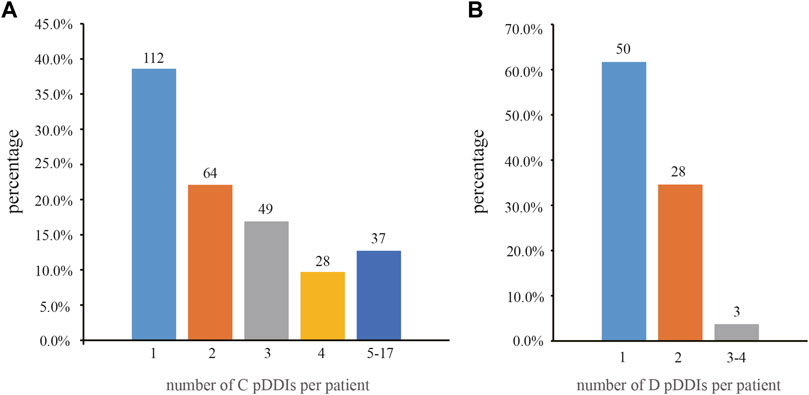
FIGURE 1. Frequency and percentage of pDDIs per patient based on risk category. (A) category C (n = 290); and (B) category D (n = 81). Percentage was calculated out of number of patients with C or D pDDIs. pDDIs, potential drug-drug interactions.
Out of 864 drug pairs we considered, 747 fell under category C (86.5%), 116 fell under category D (13.4%) and one fell under category X (0.1%). In terms of reliability, 22 (2.5%) pDDIs were excellent, 246 (28.5%) pDDIs were good, and 596 (69.0%) were fair-type. According to the Lexi-Interact classification, severity was mainly attributed to moderate (760 pDDIs, 87.9%) and major (87 pDDIs, 10.1%) (Table 4).
Drug classes involved in potential drug-drug interactions
In general, nine ATC groups were involved in category C pDDIs (Figure 2). The significantly associated drug class was drugs related to the cardiovascular system (53.9%, 806/1494). Then followed by blood and blood forming organs (22.8%, 340/1494) and the alimentary tract and metabolism (19.4%, 291/1494). Among the seven ATC groups relevant to category D and X, alimentary conditions and metabolism classification increased the exposure to DDIs (60.2%, 141/234) (Figure 2).
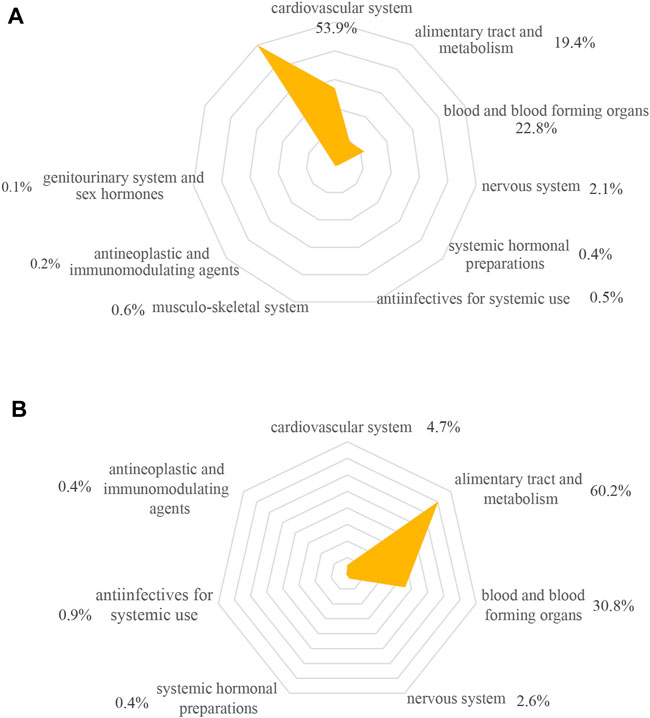
FIGURE 2. ATC classification-wise distribution of pDDIs. (A) category C (n = 1,494); (B) category D and X (n = 234). Percentage was calculated out of number of pDDIs in each risk category. pDDIs, potential drug-drug interactions.
Supplementary Table S1 presented the ATC classification of drugs. Regarding category C pDDIs, the highest frequency was found in antiplatelets (331), diabetes drugs (266), calcium channel blockers (CCBs, 179) and diuretics (176). The highest prevalence of interacting drugs within category D and X were attributed to antidiabetics (130), followed by antiplatelets (41) and anticoagulants (26) (Supplementary Table S1).
The most frequently observed drug pairs
Table 5 described the most frequently observed drug pairs and potential adverse effects. The exclusive contraindicated pair was between cyclosporin and atorvastatin. A dominant potential outcome of category D was hypoglycemia related to synergistic hypoglycemic action and the concurrent use of repaglinide with clopidogrel (69, 59.4%). Then it was followed by agents that elevated the risk of bleeding (29, 25.0%).
Exposure to clopidogrel and CCBs (110, 14.7%), as assigned to one main class C interaction, might lead to a reduced antiplatelet response with clopidogrel. Then there were drug interactions that affected blood pressure and lipids (97, 13.0% and 93, 12.4%, respectively). Notably, glycemia fluctuation was more visibly seen in diabetes who used diuretics or β blockers simultaneously (134, 17.9%). Moreover, in the aspirin group, loop diuretics, spironolactone and angiotensin converting enzyme inhibitors had an enhanced possibility of renal dysfunction (70, 9.4%).
Management strategies
The Lexi-Interact monograph also provides skilled DDIs management, as shown in Table 5. Adjustment in treatment regimens was required in category X and most category D pDDIs. Adjustments included dosage reduction, e.g. insulin, sulfonylurea and warfarin, titration e.g., repaglinide with a limit of 4 mg daily and simvastatin to 20 mg daily, separate administration time and drug replacement. Vigilant signs/symptoms and lab tests were widely recommended in class C pDDIs, including platelet reactivity index, blood pressure, blood glucose, liver/renal function and any signs or symptoms of myopathy.
Discussion
Polypharmacy is a major concern for older individuals (Soejono and Rizka, 2021). Multiple drugs carries a high risk of DDIs, and their associated adverse events vary from minor toxicity to treatment failure or even death (Malki and Pearson, 2020; Davies and O'Mahony, 2015). Our present study revealed that a high proportion of older CCS patients were exposed to pDDIs; furthermore, one fifth were classified as severe and contradictory pDDIs. pDDIs mostly involved drugs acting on the cardiovascular system, alimentary tract and metabolism, and blood and blood forming organs. It is very crucial for healthcare providers to have this data and help manage drug usage for better scheduling and planning.
Overall, the prevalence of pDDIs in CCS was higher than that in certain other scenarios, such as cancer (18.7%), intensive care unit stays (54%), dementia (43.2%), liver cirrhosis (21.5%) and COVID-19 (38%) (Franz et al., 2012; Uijtendaal et al., 2014; Sönnerstam et al., 2018; Vecchia et al., 2018; Mahboobipour and Baniasadi, 2021). Our findings were comparable with previous studies of DDI prevalence in non-acute cardiac inpatients, such as 100% in Pakistan, 61% in Serbia and 68% in Morocco (Fettah et al., 2018; Kovačević et al., 2020; Akbar et al., 2021). Medication complexity could partly explain the sizable DDIs (Forman et al., 2018). For example, all patients with acute coronary syndrome were experiencing pDDIs with 9.4 drugs on average, while only 33.4% in hypertension with daily drug use as 4.3 (Pejčić et al., 2019; Ersoy and Ersoy, 2021). Discrepancy in pDDIs could also be due to using different screening tools. In comparison of five DDI programs, including Lexi-Interact, Micromedex, iFacts, Medscape and Epocrates, Lexi-Interact and Micromedex showed the best performance on accuracy and sensitivity (Kheshti et al., 2016). Lexi-Interact was widely used in various diseases and different areas (Ren et al., 2020; Dagdelen et al., 2021; Ramsdale et al., 2022). Meanwhile, Lexi-Interact was available in our health system, as such, pDDIs were reviewed using Lexi-Interact software in this study.
In our study, DDIs of clinical significance were most frequently observed in category C. Pharmacokinetic drug interactions affect at the steps of absorption, distribution, metabolism and elimination. It has been established that the inhibition of CYP3A4 by dihydropyridine CCBs and the inhibition of P-glycoprotein by several CCBs (diltiazem, verapamil and nifedipine) were potentially harmful in clopidogrel biotransformation (Gremmel et al., 2015). However, controversy persisted as to whether CCBs modified the clinical protection of clopidogrel and subsequent changes in major adverse cardiovascular end points (Good et al., 2012; Aggarwal et al., 2016). Until now, it is difficult to determine clopidogrel resistance resulting from the co-administration of CCBs. Monitoring genetic polymorphisms or switching to ticagrelor or prasugrel might be considered for those with low efficacy of clopidogrel (Wang et al., 2015).
Most patients with hypertension required multiple drugs, such as sacubitril/valsartan or rennin-angiotensin system inhibitors with diuretics, β blockers or CCBs (Ersoy and Ersoy, 2021). However, pharmacodynamic DDIs lead to synergic blood pressure lowering, and can reduce cerebral perfusion, presenting as syncope or falls. Older adults who are taking diuretics and polypharmacy is projected a higher incidence of falls (Abu et al., 2021). Physicians and pharmacists may need to conduct a thorough assessment of antihypertensive medications as well as hidden antihypertensive medications, such as tamsulosin and levodopa (Alagiakrishnan, 2015). It is critical to emphasize blood pressure monitoring and gradual titration to a tolerance (Oliveros et al., 2020).
Nowadays, combined use of clopidogrel and rosuvastatin is common in practice. However, Pinheiro et al. (2012) reported that clopidogrel introduced impressive growth in the AUC of rosuvastatin. Meanwhile, abnormal liver function could be found in chronic heart failure (Tavazzi et al., 2008). Inhibition of intestinal breast cancer resistance protein (BCRP) transporters by clopidogrel is likely to be a contributor of hepatotoxicity (Ning et al., 2021). Once daily clopidogrel is advised to be taken either in the morning or evening, while rosuvastatin in the evening.
Two-fifths of CCS patients in this study had type 2 diabetes mellitus. Meta analysis showed thiazide diuretics and β blockers increased the risk of developing new-onset diabetes (Nazarzadeh et al., 2021). The diuretic-decreased pharmacologic response was related to a reduction in insulin secretion secondary to potassium loss. The mechanism of β-blocking agents on glycemia-related adverse events is complex, including increased insulin resistance and the inhibition of adrenergic-mediated insulin release (Jain et al., 2017). Carvedilol seemed superior to metoprolol with a lower impact on glycemic control and more benefits on metabolic syndrome (Bakris et al., 2004). It is necessary to monitor blood glucose and refine the selection of drug choice according to an individual’s risk/benefit profile.
Rhabdomyolysis particularly occurs with drugs that potentiate statin concentration. The only interaction of category X was cyclosporine-atorvastatin regimen. Cyclosporine acts as an inhibitor of CYP3A4, p-gp and OATP1B1, resulting in a drastically elevated atorvastatin level (Bellosta and Corsini, 2018). Fluvastatin or pravastatin might be prudent to choose for CCS patients already treated with cyclosporine (Horodinschi et al., 2019).
For decades, emergency department visits for ADEs in older adults were primarily concerned with the augmented proportion of anticoagulants, antiplatelets and antidiabetics (Shehab et al., 2016). In line with this, category D DDIs at large were noted to cause detrimental hypoglycemia and bleeding. To date, add-on therapy was more prevalent than metformin monotherapy in older patients (Kim et al., 2019). Nevertheless, glucose-lowering agents might be associated with serious hypoglycemia when used in conjunction with sulfonylureas or insulin (Gómez-Huelgas et al., 2020). Both SGLT2 inhibitors and glucagon-like peptide-1 receptor agonists (GLP-1 RA) have been proven to reduce major adverse cardiovascular events with little risk of hypoglycemia (Bertoccini and Baroni, 2021). The utilization of both drugs in the present study was at a low frequency (2.4% for SGLT2 inhibitors and 5.3% for GLP-1 RA). Mitigation of hypoglycemia risk could be achieved by the selection of appropriate antidiabetic drugs, glucose self-monitoring and education on hypoglycemia symptoms.
Another challenge was to maintain balance with regards to ischemic and bleeding risks in CCS with atrial fibrillation. Co-prescription of anticoagulants with antiplatelets, especially in triple therapy, increased the absolute risk of bleeding (Michniewicz et al., 2018). Meta-analysis supported novel oral anticoagulants plus a P2Y12 inhibitor in atrial fibrillation experiencing post-percutaneous coronary interventions (Lopes et al., 2020). Good clinical judgment on drugs with better efficacy, dosage and duration is vital in patients management.
pDDIs is prevalent in older CCS patients, indicating a need to evaluate medication safety and strict monitoring during CCS treatment. DDI screening and alerting systems should be implemented in electronic medical records (Celebi et al., 2019; Horn and Ueng, 2019; Anrys et al., 2021). Pharmacist-driven prescription review system in real time has been allowed to optimize therapy (Lineberry et al., 2021). In certain instances, a multidisciplinary team with a physician, a pharmacist and a nurse was required especially in complex drug regimens (Silva et al., 2015; Aghili and Kasturirangan, 2021). Clinical pharmacists should also make attempts at patient education and counseling to reduce the incidence of serious or fatal DDIs (Riu-Viladoms et al., 2019).
The results of the current real-life setting yields pragmatic information on medications that might pose risk in older CCS patients. Some limitations should be considered. The current design focused on pDDIs and did not identify actual clinical manifestations, such as persistent use and doses of drugs. A follow-up for potential clinical outcomes and relevant interventions is required. Second, a multicenter study might allow data to be more generalizable. Third, although the wide use of Lexi-Interact database, it could not provide information on whether drug combinations were appropriate in certain circumstances. For instance, valsartan and potassium chloride are sometimes concomitantly used in an implantable cardioverter-defibrillator recipient with hypokalemia. Fourth, older adults in China preferred to take herbs as self-medications, and many of them were unwilling to inform doctors or clinical pharmacists. As a result, potential interactions between medicines and herbs tend to be underestimated.
Conclusion
The present study showed a substantial proportion of older CCS patients were exposed to pDDIs at discharge, and one fifth were involved in serious or contraindicated DDIs. Thus, judicious clinicians should be more knowledgeable and cautious in recognizing and minimizing undesirable adverse events. In the multidisciplinary team, well-trained clinical pharmacists are responsible for comprehensive medication reviews. Furthermore, data obtained in this study can be used to design DDIs screening and alert interventions to optimize patient care.
Data availability statement
The original contributions presented in the study are included in the article/Supplementary Material, further inquiries can be directed to the corresponding author.
Ethics statement
The studies involving human participants were reviewed and approved by the Ethics Committee of Peking University People’s Hospital. Written informed consent for participation was not required for this study in accordance with the national legislation and the institutional requirements.
Author contributions
MZ: designing, methodology, data curation, investigation, writing and editing. C-FL: designing, data curation, investigation, supervision, editing and review. Y-FF: methodology, review and editing. HC: conceptualization, supervision, review and editing. All authors provided final approval of the final version to be submitted.
Funding
This study was supported by the National Natural Science Foundation of China (No. 81970301).
Conflict of interest
The authors declare that the research was conducted in the absence of any commercial or financial relationships that could be construed as a potential conflict of interest.
Publisher’s note
All claims expressed in this article are solely those of the authors and do not necessarily represent those of their affiliated organizations, or those of the publisher, the editors and the reviewers. Any product that may be evaluated in this article, or claim that may be made by its manufacturer, is not guaranteed or endorsed by the publisher.
Supplementary material
The Supplementary Material for this article can be found online at: https://www.frontiersin.org/articles/10.3389/fphar.2022.946415/full#supplementary-material
References
Abu, B. A., Abdul, K. A., Idris, N. S., and Mohd, N. S. (2021). Older adults with hypertension: Prevalence of falls and their associated factors. Int. J. Environ. Res. Public Health 18 (16), 8257. doi:10.3390/ijerph18168257
Aggarwal, S., Loomba, R. S., and Arora, R. R. (2016). Effects of concurrent calcium channel blocker on antiplatelet efficacy of clopidogrel therapy: A systematic review. Am. J. Ther. 23 (1), e29–36. doi:10.1097/MJT.0000000000000225
Aghili, M., and Kasturirangan, M. N. (2021). Management of drug-drug interactions among critically ill patients with chronic kidney disease: Impact of clinical pharmacist's interventions. Indian J. Crit. Care Med. 25 (11), 1226–1231. doi:10.5005/jp-journals-10071-23919
Akbar, Z., Rehman, S., Khan, A., Khan, A., Atif, M., and Ahmad, N. (2021). Potential drug-drug interactions in patients with cardiovascular diseases: Findings from a prospective observational study. J. Pharm. Policy Pract. 14 (1), 63. doi:10.1186/s40545-021-00348-1
Alagiakrishnan, K. (2015). Current pharmacological management of hypotensive syndromes in the elderly. Drugs Aging 32 (5), 337–348. doi:10.1007/s40266-015-0263-z
Alqenae, F. A., Steinke, D., and Keers, R. N. (2020). Prevalence and nature of medication errors and medication-related harm following discharge from hospital to community settings: A systematic review. Drug Saf. 43 (6), 517–537. doi:10.1007/s40264-020-00918-3
Anrys, P., Petit, A. E., Thevelin, S., Sallevelt, B., Drenth, C., Soiza, R. L., et al. (2021). An international consensus list of potentially clinically significant drug-drug interactions in older people. J. Am. Med. Dir. Assoc. 22 (10), 2121–2133.e24. doi:10.1016/j.jamda.2021.03.019
Bakris, G. L., Fonseca, V., Katholi, R. E., McGill, J. B., Messerli, F. H., Phillips, R. A., et al. (2004). Metabolic effects of Carvedilol vs metoprolol in patients with type 2 diabetes mellitus and hypertension: A randomized controlled trial. JAMA 292 (18), 2227–2236. doi:10.1001/jama.292.18.2227
Bansilal, S., Castellano, J. M., and Fuster, V. (2015). Global burden of CVD: Focus on secondary prevention of cardiovascular disease. Int. J. Cardiol. 201 (1), S1–S7. doi:10.1016/S0167-5273(15)31026-3
Becker, M. L., Kallewaard, M., Caspers, P. W., Visser, L. E., Leufkens, H. G., and Stricker, B. H. (2007). Hospitalisations and emergency department visits due to drug-drug interactions: A literature review. Pharmacoepidemiol. Drug Saf. 16 (6), 641–651. doi:10.1002/pds.1351
Beinse, G., Reitter, D., Segaux, L., Carvahlo-Verlinde, M., Rousseau, B., Tournigand, C., et al. (2020). Potential drug-drug interactions and risk of unplanned hospitalization in older patients with cancer: A survey of the prospective elcapa (ELderly CAncer PAtients) cohort. J. Geriatr. Oncol. 11 (4), 586–592. doi:10.1016/j.jgo.2019.07.023
Bellosta, S., and Corsini, A. (2018). Statin drug interactions and related adverse reactions: An update. Expert Opin. Drug Saf. 17 (1), 25–37. doi:10.1080/14740338.2018.1394455
Bertoccini, L., and Baroni, M. G. (2021). GLP-1 receptor agonists and SGLT2 inhibitors for the treatment of type 2 diabetes: New insights and opportunities for cardiovascular protection. Adv. Exp. Med. Biol. 1307, 193–212. doi:10.1007/5584_2020_494
Celebi, R., Uyar, H., Yasar, E., Gumus, O., Dikenelli, O., and Dumontier, M. (2019). Evaluation of knowledge graph embedding approaches for drug-drug interaction prediction in realistic settings. BMC Bioinforma. 20 (1), 726. doi:10.1186/s12859-019-3284-5
Dagdelen, M. S., Gulen, D., Ceylan, I., and Girgin, N. K. (2021). Evaluation of potential drug-drug interactions in intensive care unit. Eur. Rev. Med. Pharmacol. Sci. 25 (18), 5801–5806. doi:10.26355/eurrev_202109_26798
Davies, E. A., and O'Mahony, M. S. (2015). Adverse drug reactions in special populations - the elderly. Br. J. Clin. Pharmacol. 80 (4), 796–807. doi:10.1111/bcp.12596
Ersoy, 0., and Ersoy, P. (2021). Effects of new drug interaction index on drug adherence in older patients with hypertension. Turk Kardiyol. Dern. Ars. 49 (7), 545–552. doi:10.5543/tkda.2021.21869
Ferrari, R., Pavasini, R., Censi, S., Squeri, A., and Rosano, G. (2021). The new ESC guidelines for the diagnosis and management of chronic coronary syndromes: The good and the not so good. Curr. Probl. Cardiol. 46 (3), 100554. doi:10.1016/j.cpcardiol.2020.100554
Fettah, H., Moutaouakkil, Y., Sefrioui, M. R., Moukafih, B., Bousliman, Y., Bennana, A., et al. (2018). Detection and analysis of drug-drug interactions among hospitalized cardiac patients in the mohammed V military teaching hospital in Morocco. Pan Afr. Med. J. 29, 225. doi:10.11604/pamj.2018.29.225.14169
Forman, D. E., Maurer, M. S., Boyd, C., Brindis, R., Salive, M. E., Horne, F. M., et al. (2018). Multimorbidity in older adults with cardiovascular disease. J. Am. Coll. Cardiol. 71 (19), 2149–2161. doi:10.1016/j.jacc.2018.03.022
Franz, C. C., Egger, S., Born, C., Rätz, B. A., and Krähenbühl, S. (2012). Potential drug-drug interactions and adverse drug reactions in patients with liver cirrhosis. Eur. J. Clin. Pharmacol. 68 (2), 179–188. doi:10.1007/s00228-011-1105-5
Gallo, P., De Vincentis, A., Pedone, C., Nobili, A., Tettamanti, M., Gentilucci, U. V., et al. (2019). Drug-drug interactions involving CYP3A4 and P-glycoprotein in hospitalized elderly patients. Eur. J. Intern. Med. 65, 51–57. doi:10.1016/j.ejim.2019.05.002
Gatenby, J., Blomqvist, M., Burke, R., Ritchie, A., Gibson, K., and Patanwala, A. E. (2020). Adverse events targeted by drug-drug interaction alerts in hospitalized patients. Int. J. Med. Inf. 143, 104266. doi:10.1016/j.ijmedinf.2020.104266
Gelchu, T., and Abdela, J. (2019). Drug therapy problems among patients with cardiovascular disease admitted to the medical ward and had a follow-up at the ambulatory clinic of hiwot fana specialized university hospital: The case of a tertiary hospital in eastern Ethiopia. SAGE Open Med. 7, 2050312119860401. doi:10.1177/2050312119860401
Gómez-Huelgas, R., González, D., Abadias, M., Puig, J., and Ena, J. (2020). Prescription patterns of antihyperglycemic drugs in elderly patients in Spain: A national cross-sectional study. Rev. Clin. Esp. 220 (3), 155–161. doi:10.1016/j.rce.2019.05.011
Good, C. W., Steinhubl, S. R., Brennan, D. M., Lincoff, A. M., Topol, E. J., and Berger, P. B. (2012). Is there a clinically significant interaction between calcium channel antagonists and clopidogrel?: Results from the clopidogrel for the reduction of events during observation (CREDO) trial. Circ. Cardiovasc. Interv. 5 (1), 77–81. doi:10.1161/CIRCINTERVENTIONS.111.963405
Grandchamp, S., Blanc, A. L., Roussel, M., Tagan, D., Sautebin, A., Dobrinas-Bonazzi, M., et al. (2022). Pharmaceutical interventions on hospital discharge prescriptions: Prospective observational study highlighting challenges for community pharmacists. Drugs Real World Outcomes 9 (2), 253–261. doi:10.1007/s40801-021-00288-x
Gremmel, T., Durstberger, M., Eichelberger, B., Koppensteiner, R., and Panzer, S. (2015). Calcium-channel blockers attenuate the antiplatelet effect of clopidogrel. Cardiovasc. Ther. 33 (5), 264–269. doi:10.1111/1755-5922.12138
Hessami, A., Shamshirian, A., Heydari, K., Pourali, F., Alizadeh-Navaei, R., Moosazadeh, M., et al. (2021). Cardiovascular diseases burden in COVID-19: Systematic review and meta-analysis. Am. J. Emerg. Med. 46, 382–391. doi:10.1016/j.ajem.2020.10.022
Hines, L. E., and Murphy, J. E. (2011). Potentially harmful drug-drug interactions in the elderly: A review. Am. J. Geriatr. Pharmacother. 9 (6), 364–377. doi:10.1016/j.amjopharm.2011.10.004
Horn, J., and Ueng, S. (2019). The effect of patient-specific drug-drug interaction alerting on the frequency of alerts: A pilot study. Ann. Pharmacother. 53 (11), 1087–1092. doi:10.1177/1060028019863419
Horodinschi, R. N., Stanescu, A., Bratu, O. G., Pantea, S. A., Radavoi, D. G., and Diaconu, C. C. (2019). Treatment with statins in elderly patients. Med. Kaunas. 55 (11), 721. doi:10.3390/medicina55110721
Jain, V., Patel, R. K., Kapadia, Z., Galiveeti, S., Banerji, M., and Hope, L. (2017). Drugs and hyperglycemia: A practical guide. Maturitas 104, 80–83. doi:10.1016/j.maturitas.2017.08.006
Kheshti, R., Aalipour, M., and Namazi, S. (2016). A comparison of five common drug-drug interaction software programs regarding accuracy and comprehensiveness. J. Res. Pharm. Pract. 5 (4), 257–263. doi:10.4103/2279-042X.192461
Kim, J., Park, S., Kim, H., and Je, N. K. (2019). National trends in metformin-based combination therapy of oral hypoglycaemic agents for type 2 diabetes mellitus. Eur. J. Clin. Pharmacol. 75 (12), 1723–1730. doi:10.1007/s00228-019-02751-9
Knuuti, J., Wijns, W., Saraste, A., Capodanno, D., Barbato, E., Funck-Brentano, C., et al. (2020). 2019 ESC guidelines for the diagnosis and management of chronic coronary syndromes. Eur. Heart J. 41 (3), 407–477. doi:10.1093/eurheartj/ehz425
Kovačević, M., Vezmar, K. S., Radovanović, S., Stevanović, P., and Miljković, B. (2020). Potential drug-drug interactions associated with clinical and laboratory findings at hospital admission. Int. J. Clin. Pharm. 42 (1), 150–157. doi:10.1007/s11096-019-00951-y
Lea, M., Mowe, M., Mathiesen, L., Kvernrød, K., Skovlund, E., and Molden, E. (2019). Prevalence and risk factors of drug-related hospitalizations in multimorbid patients admitted to an internal medicine ward. PLoS One 14 (7), e0220071. doi:10.1371/journal.pone.0220071
Limandri, B. J. (2020). Adverse events, drug interactions, and treatment adherence. J. Psychosoc. Nurs. Ment. Health Serv. 58 (2), 9–13. doi:10.3928/02793695-20200117-02
Lineberry, E., Rozycki, E., Jordan, T. A., Mellett, J., and North, A. M. (2021). Implementation of pharmacist targeted discharge prescription review in an emergency department. Am. J. Emerg. Med. 48, 288–294. doi:10.1016/j.ajem.2021.04.054
Lopes, R. D., Hong, H., Harskamp, R. E., Bhatt, D. L., Mehran, R., Cannon, C. P., et al. (2020). Optimal antithrombotic regimens for patients with atrial fibrillation undergoing percutaneous coronary intervention: An updated network meta-analysis. JAMA Cardiol. 5 (5), 582–589. doi:10.1001/jamacardio.2019.6175
Magro, L., Moretti, U., and Leone, R. (2012). Epidemiology and characteristics of adverse drug reactions caused by drug-drug interactions. Expert Opin. Drug Saf. 11 (1), 83–94. doi:10.1517/14740338.2012.631910
Mahboobipour, A. A., and Baniasadi, S. (2021). Clinically important drug-drug interactions in patients admitted to hospital with COVID-19: Drug pairs, risk factors, and management. Drug Metabol. Drug Interact. 36 (1), 9–16. doi:10.1515/dmpt-2020-0145
Malki, M. A., and Pearson, E. R. (2020). Drug-drug-gene interactions and adverse drug reactions. Pharmacogenomics J. 20 (3), 355–366. doi:10.1038/s41397-019-0122-0
Michniewicz, E., Mlodawska, E., Lopatowska, P., Tomaszuk-Kazberuk, A., and Malyszko, J. (2018). Patients with atrial fibrillation and coronary artery disease - double trouble. Adv. Med. Sci. 63 (1), 30–35. doi:10.1016/j.advms.2017.06.005
Moradi, O., Karimzadeh, I., Davani-Davari, D., Shafiekhani, M., Sagheb, M. M., and Raees-Jalali, G. A. (2020). Drug-drug interactions among kidney transplant recipients in the outpatient setting. Int. J. Organ Transpl. Med. 11 (4), 185–195.
Moura, C. S., Acurcio, F. A., and Belo, N. O. (2009). Drug-drug interactions associated with length of stay and cost of hospitalization. J. Pharm. Pharm. Sci. 12 (3), 266–272. doi:10.18433/j35c7z
Nazarzadeh, M., Bidel, Z., Canoy, D., Copland, E., Wamil, M., Majert, J., et al. (2021). Blood pressure lowering and risk of new-onset type 2 diabetes: An individual participant data meta-analysis. Lancet 398 (10313), 1803–1810. doi:10.1016/S0140-6736(21)01920-6
Nightingale, G., Pizzi, L. T., Barlow, A., Barlow, B., Jacisin, T., McGuire, M., et al. (2018). The prevalence of major drug-drug interactions in older adults with cancer and the role of clinical decision support software. J. Geriatr. Oncol. 9 (5), 526–533. doi:10.1016/j.jgo.2018.02.001
Ning, C., Su, S., Li, J., Kong, D., Cai, H., Qin, Z., et al. (2021). Evaluation of a clinically relevant drug-drug interaction between rosuvastatin and clopidogrel and the risk of hepatotoxicity. Front. Pharmacol. 12, 715577. doi:10.3389/fphar.2021.715577
Oliveros, E., Patel, H., Kyung, S., Fugar, S., Goldberg, A., Madan, N., et al. (2020). Hypertension in older adults: Assessment, management, and challenges. Clin. Cardiol. 43 (2), 99–107. doi:10.1002/clc.23303
Pejčić, A. V., Janković, S. M., and Davidović, G. (2019). Drug-drug interactions in patients with acute coronary syndrome across phases of treatment. Intern. Emerg. Med. 14 (3), 411–422. doi:10.1007/s11739-018-1994-8
Pinheiro, L. F., França, C. N., Izar, M. C., Barbosa, S. P., Bianco, H. T., Kasmas, S. H., et al. (2012). Pharmacokinetic interactions between clopidogrel and rosuvastatin: Effects on vascular protection in subjects with coronary heart disease. Int. J. Cardiol. 158 (1), 125–129. doi:10.1016/j.ijcard.2012.04.051
Plácido, A. I., Herdeiro, M. T., Morgado, M., Figueiras, A., and Roque, F. (2020). Drug-related problems in home-dwelling older adults: A systematic review. Clin. Ther. 42 (4), 559–572.e14. doi:10.1016/j.clinthera.2020.02.005
Prince, M. J., Wu, F., Guo, Y., Gutierrez, R. L., O'Donnell, M., Sullivan, R., et al. (2015). The burden of disease in older people and implications for health policy and practice. Lancet 385 (9967), 549–562. doi:10.1016/S0140-6736(14)61347-7
Ramsdale, E., Mohamed, M., Yu, V., Otto, E., Juba, K., Awad, H., et al. (2022). Polypharmacy, potentially inappropriate medications, and drug-drug interactions in vulnerable older adults with advanced cancer initiating cancer treatment. Oncologist 27, e580–e588. doi:10.1093/oncolo/oyac053
Ren, W., Liu, Y., Zhang, J., Fang, Z., Fang, H., Gong, Y., et al. (2020). Prevalence of potential drug-drug interactions in outpatients of a general hospital in China: A retrospective investigation. Int. J. Clin. Pharm. 42 (4), 1190–1196. doi:10.1007/s11096-020-01068-3
Riu-Viladoms, G., Carcelero, S. M. E., Martín-Conde, M. T., and Creus, N. (2019). Drug interactions with oral antineoplastic drugs: The role of the pharmacist. Eur. J. Cancer Care 28 (1), e12944. doi:10.1111/ecc.12944
Romero-Farina, G., and Aguadé-Bruix, S. (2021). Planning the follow-up of patients with stable chronic coronary artery disease. Diagn. (Basel) 11 (10), 1762. doi:10.3390/diagnostics11101762
Ruangritchankul, S., Peel, N. M., Hanjani, L. S., and Gray, L. C. (2020). Drug related problems in older adults living with dementia. PLoS One 15 (7), e0236830. doi:10.1371/journal.pone.0236830
Seid, E., Engidawork, E., Alebachew, M., Mekonnen, D., and Berha, A. B. (2020). Evaluation of drug therapy problems, medication adherence and treatment satisfaction among heart failure patients on follow-up at a tertiary care hospital in Ethiopia. PLoS One 15 (8), e0237781. doi:10.1371/journal.pone.0237781
Shehab, N., Lovegrove, M. C., Geller, A. I., Rose, K. O., Weidle, N. J., and Budnitz, D. S. (2016). US emergency department visits for outpatient Adverse drug events, 2013-2014. JAMA 316 (20), 2115–2125. doi:10.1001/jama.2016.16201
Shetty, V., Chowta, M. N., Chowta, K. N., Shenoy, A., Kamath, A., and Kamath, P. (2018). Evaluation of potential drug-drug interactions with medications prescribed to geriatric patients in a tertiary care hospital. J. Aging Res. 2018, 5728957. doi:10.1155/2018/5728957
Silber, S. (2019). ESC guidelines 2019 on chronic coronary syndrome (CCS, previously "stable coronary artery disease"): What is new? What is particularly important? Herz 44 (8), 676–683. doi:10.1007/s00059-019-04862-6
Silva, C., Ramalho, C., Luz, I., Monteiro, J., and Fresco, P. (2015). Drug-related problems in institutionalized, polymedicated elderly patients: Opportunities for pharmacist intervention. Int. J. Clin. Pharm. 37 (2), 327–334. doi:10.1007/s11096-014-0063-2
Soejono, C. H., and Rizka, A. (2021). Polypharmacy and drug use pattern among Indonesian elderly patients visiting emergency unit. Acta Med. Indones. 53 (1), 60–76.
Sönnerstam, E., Sjölander, M., Lövheim, H., and Gustafsson, M. (2018). Clinically relevant drug-drug interactions among elderly people with dementia. Eur. J. Clin. Pharmacol. 74 (10), 1351–1360. doi:10.1007/s00228-018-2514-5
Tavazzi, L., Maggioni, A. P., Marchioli, R., Barlera, S., Franzosi, M. G., Latini, R., et al. (2008). Effect of rosuvastatin in patients with chronic heart failure (the GISSI-HF trial): A randomised, double-blind, placebo-controlled trial. Lancet 372 (9645), 1231–1239. doi:10.1016/S0140-6736(08)61240-4
Thomsen, L. A., Winterstein, A. G., Søndergaard, B., Haugbølle, L. S., and Melander, A. (2007). Systematic review of the incidence and characteristics of preventable Adverse drug events in ambulatory care. Ann. Pharmacother. 41 (9), 1411–1426. doi:10.1345/aph.1H658
Tsige, A. W., Yikna, B. B., and Altaye, B. M. (2021). Drug-related problems among ambulatory heart failure patients on follow-up at debre berhan comprehensive specialized hospital, Ethiopia. Ther. Clin. Risk Manag. 17, 1165–1175. doi:10.2147/TCRM.S337256
Uijtendaal, E. V., van Harssel, L. L., Hugenholtz, G. W., Kuck, E. M., Zwart-van, R. J., Cremer, O. L., et al. (2014). Analysis of potential drug-drug interactions in medical intensive care unit patients. Pharmacotherapy 34 (3), 213–219. doi:10.1002/phar.1395
Vecchia, S., Orlandi, E., Confalonieri, C., Damonti, E., Riva, A., Sartori, A., et al. (2018). Prevalence study on potential drug-drug interaction in cancer patients in piacenza hospital's onco-haematology department. J. Oncol. Pharm. Pract. 24 (7), 490–493. doi:10.1177/1078155217717324
Veloso, R., Figueredo, T. P., Barroso, S., Nascimento, M., and Reis, A. (2019). Factors associated with drug interactions in elderly hospitalized in high complexity hospital. Cien. Saude Colet. 24 (1), 17–26. doi:10.1590/1413-81232018241.32602016
Wang, Z. Y., Chen, M., Zhu, L. L., Yu, L. S., Zeng, S., Xiang, M. X., et al. (2015). Pharmacokinetic drug interactions with clopidogrel: Updated review and risk management in combination therapy. Ther. Clin. Risk Manag. 11, 449–467. doi:10.2147/TCRM.S80437
Yasuda, S., Miyamoto, Y., and Ogawa, H. (2018). Current status of cardiovascular medicine in the aging society of Japan. Circulation 138 (10), 965–967. doi:10.1161/CIRCULATIONAHA.118.035858
Yoon, S. J., Kim, J. S., Jung, J. G., Ahn, S. K., Song, Y. S., Bae, N. K., et al. (2018). Factors associated with potentially harmful drug-drug interactions in older Korean people: A population-based study. Geriatr. Gerontol. Int. 18 (9), 1378–1382. doi:10.1111/ggi.13495
Zahmatkeshan, N., Khademian, Z., Zarshenas, L., and Rakhshan, M. (2021). Experience of adherence to treatment among patients with coronary artery disease during the COVID-19 pandemic: A qualitative study. Health promot. Perspect. 11 (4), 467–475. doi:10.34172/hpp.2021.59
Zhao, D., Liu, J., Wang, M., Zhang, X., and Zhou, M. (2019). Epidemiology of cardiovascular disease in China: Current features and implications. Nat. Rev. Cardiol. 16 (4), 203–212. doi:10.1038/s41569-018-0119-4
Keywords: drug-drug interactions, chronic coronary syndrome, older adults, discharge, drug therapy
Citation: Zhao M, Liu C-F, Feng Y-F and Chen H (2022) Potential drug-drug interactions in drug therapy for older adults with chronic coronary syndrome at hospital discharge: A real-world study. Front. Pharmacol. 13:946415. doi: 10.3389/fphar.2022.946415
Received: 17 May 2022; Accepted: 22 July 2022;
Published: 24 August 2022.
Edited by:
Fabiane Raquel Motter, University of Sorocaba, BrazilReviewed by:
Fátima Roque, Instituto Politécnico da Guarda, PortugalKaloyan Georgiev, Medical University of Varna, Bulgaria
Elizaveta Zbyshevskaya, North-Western State Medical University named after I. I. Mechnikov, Russia
Copyright © 2022 Zhao, Liu, Feng and Chen. This is an open-access article distributed under the terms of the Creative Commons Attribution License (CC BY). The use, distribution or reproduction in other forums is permitted, provided the original author(s) and the copyright owner(s) are credited and that the original publication in this journal is cited, in accordance with accepted academic practice. No use, distribution or reproduction is permitted which does not comply with these terms.
*Correspondence: Hong Chen, Y2hlbmhvbmdiakBtZWRtYWlsLmNvbS5jbg==
†These authors have contributed equally to this work and share first authorship
 Mei Zhao
Mei Zhao Chuan-Fen Liu
Chuan-Fen Liu Yu-Fei Feng1
Yu-Fei Feng1 Hong Chen
Hong Chen